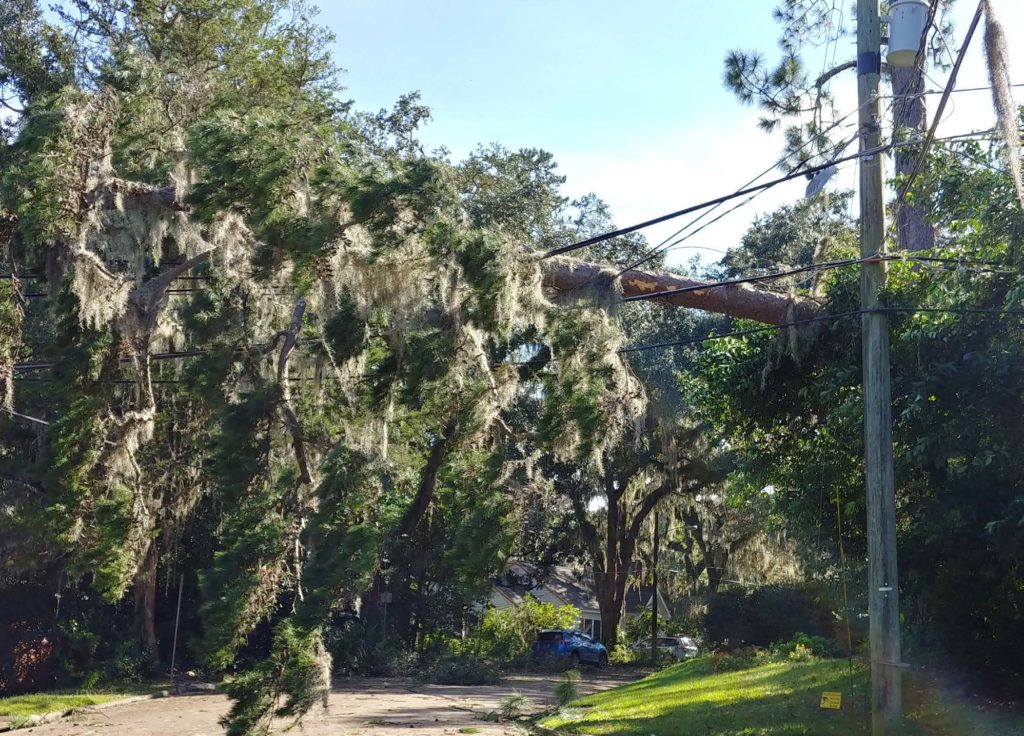
Hurricane could put dent in Florida budget

Hurricane Michael caused widespread damage across the Florida Panhandle. Photo by St. Clair Murraine
The News Service of Florida
Florida’s budget will face increased pressure from the impact of Hurricane Michael, a new report reviewed recently by the Senate Appropriations Committee showed.
The state’s costs for emergency-relief and recovery efforts related to Michael, a major storm that struck the Panhandle in October, will exceed the costs for Hurricane Irma, a 2017 storm that damaged a larger portion of the state, the report said.
The hurricane impact and factors showing slower economic growth are enough for state analysts to now project that a potential $223 million budget surplus for 2019-2020 — outlined in a September report — “has likely disappeared.”
“The projected discretionary balance identified in September has gone to zero (in the best case scenario) or is negative by as much as $250 million (in the more realistic scenario), as a result of Hurricane Michael and the (revenue-estimating) conferences held to date,” according to the revised long-range financial outlook.
Senate Appropriations Chairman Rob Bradley, R-Fleming Island, said the new report means lawmakers will have to be “even more diligent in making sure that we are very, very conservative” in their approach to the new state budget and revenue projections. Lawmakers will work on a 2019-2020 budget during the annual session that starts in March.
“The numbers speak for themselves,” Bradley said after the meeting. “Hurricane Michael was devastating for the people of the Panhandle and the people of the state of Florida. But it also adds real enduring effects on our budget this year and in future years. And we need to be mindful of that as we build our budget.”
The financial impact of Michael has been amplified because it struck a largely rural portion of the state that was already “economically challenged” prior to the storm, with lower wages and higher poverty than many areas in Florida, the report said.
“Their capacity to recover from Michael is probably less than counties that were most affected by Irma,” Amy Baker, coordinator for the Legislature’s Office of Economic and Demographic Research, told the Senate committee.
She also said a larger portion of homes in the region did not have mortgages — 14.8 percent have mortgages, compared to a statewide average of 23 percent — meaning homeowners were more likely to lack property insurance to help them rebuild after the storm.
The absence of insurance is one of the reasons why state analysts are not projecting a short-term boost in sales tax revenue from Michael as residents rebuild and make major purchases, such as for appliances.
“We are not anticipating there will be a discrete positive adjustment to the sales tax,” Baker told the senators.
In contrast, after Irma, Baker said analysts projected a $354 million boost in the short-term sales tax collections.
Eventually, some of the state’s storm recovery costs will be reimbursed by the federal government. But Baker said that based on the experience with Irma, it will take time.
The report showed the state spent some $776 million in general revenue and trust fund money for Irma that may be reimbursed.
But through August, the Federal Emergency Management Agency had only provided $69.6 million to the state, with another $47.6 million in September to pay for students displaced by Irma and other storms.
“We’re waiting on a lot of money to come back, but it’s not yet in the state’s coffers. I point that out to say it’s a long time from when the state makes its initial investment to when it gets reimbursed,” Baker said.
Other factors that could impact state revenues in the next three years are a residential construction industry that has not reached its pre-recession peak and the impact of a stronger U.S. dollar on international tourism, the report said.
Baker said a stronger dollar could make Florida less attractive to foreign visitors, which could impact tourism expenditures that account for about 13 percent of Florida’s annual sales tax collections.
On the positive side, the state budget includes $3.5 billion in reserves that could help mitigate some immediate financial challenges, the report said.
The revenue forecast will be further impacted as state analysts finish projections for school enrollment and expenditures related to Medicaid, the state-federal health care program for poor and disabled people, Baker said.
State analysts met a week ago to make another projection of the state’s general revenue funds, which amount to more than $32 billion in the current state budget The overall budget is just under $90 billion.







